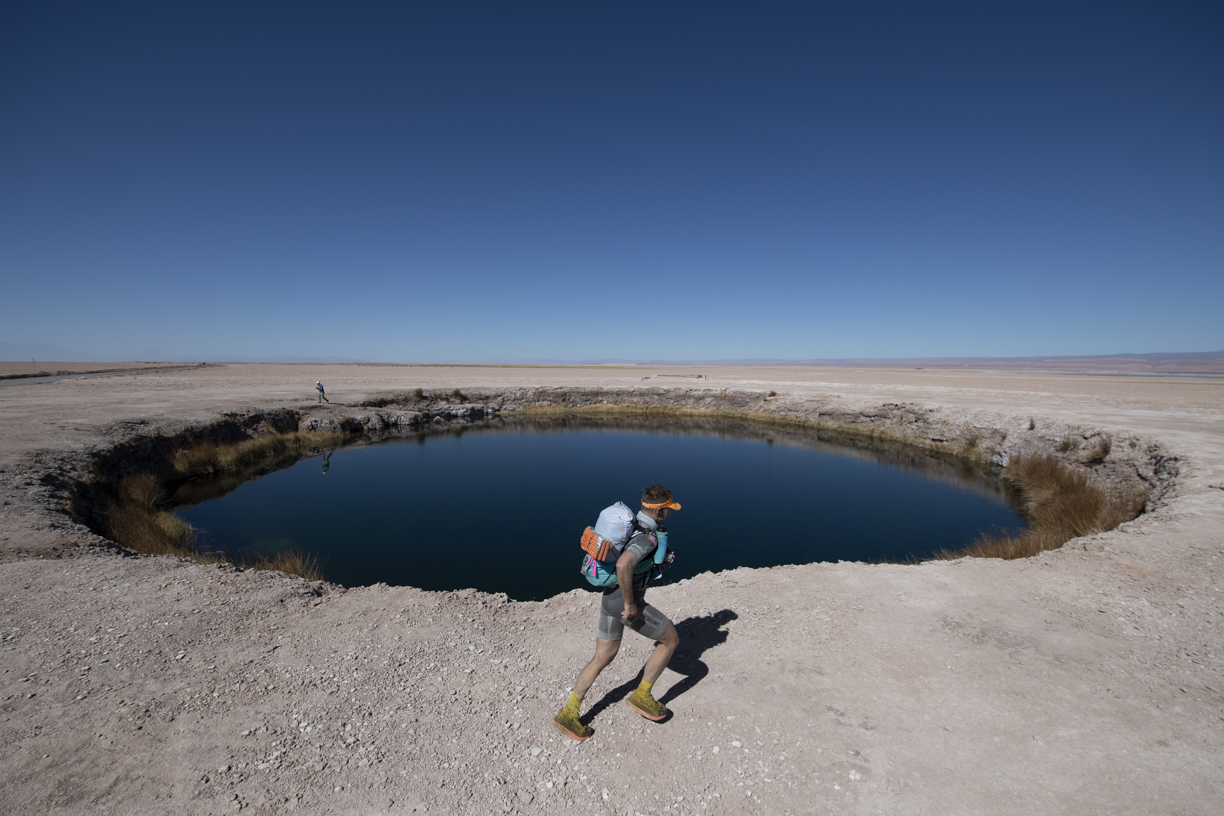1K12M: How Kidney Donors Matt Cavanaugh & Hilary Baude Save Lives and Keep on Running
Donate a kidney, win one of the most grueling ultramarathons out there? No problem. And for active duty US Army Strategist, runner, and living kidney donor Matt Cavanaugh, it was just a warm-up. This year, together with teacher, athlete, and another living kidney donor Hilary Baude, they’re taking on 12 marathons to show runners that “they can save lives,” as Cavanaugh said. As a part of this 1K12M Project, they’re coming to San Francisco this month to conquer the hills of our beautiful city and spread their message.
Written & edited by Pavlína Marek
1. 1K12M: 1 Kidney, 12 Marathons
Why are Living-Donor Kidney Transplants Important?
2. The Road to Running: Deserts, Depression, Donation, and Determination
Matt Cavanaugh
– The Past
– The Donation
– 1 Kidney, 4 Deserts: Racing the Planet’s Grand Slam
Hilary Baude
– The Past
– The Donation
3. The Why: The Decision to Donate
Hilary Baude
Matt Cavanaugh
4. How 1K12M Came to Be
5. The National Kidney Donation Organization & The Living Donor Games
The Numbers
The Games
6. 1K12M and the San Francisco Marathon
7. Next: Wilson Du, the Renal Warrior
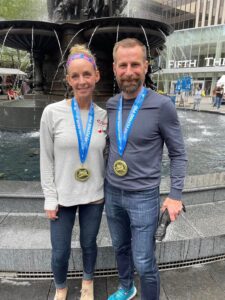
Hilary Baude & Matt Cavanaugh at the Flying Pig Marathon in Cincinnati. Photo credit: Steve Wilson/NKDO.
1K12M: 1 Kidney, 12 Marathons
The 1K12M project is backed by Living Donor Games, an organization that aims to showcase “the impressive health and fitness of donors from around the country” and thus alleviate possible fears and concerns about becoming a living donor. As the name of the project suggests, Cavanaugh and Baude’s goal is to run 12 marathons in one year. During their marathon journey, they aim to spread awareness about living kidney donations and inspire people to become living kidney donors.
“We want runners to know that they can save lives. That they can donate a kidney, save a life, and then go on to do all the big and bold athletic things they were doing before. For some runners, that is just going to make sense.”
—Matt Cavanaugh
As of now, the athletes have completed six marathons, touching the lives of people in every city they ran in. The San Francisco Marathon is next and just like everywhere else, Baude and Cavanaugh are ready to make a difference. Check out the project website to see how you can help, learn about live kidney donation, and see where the athletes are headed next.
Why are Living-Donor Kidney Transplants Important?
Even if we skim over the fact that there are simply not enough posthumous donors, there are many other factors at play. One of the more significant issues is the lifespan of a donated kidney; kidneys from living donors last almost twice as long as kidneys from deceased donors according to the National Kidney Donation Organization (NKDO). This means a longer and higher-quality life for the kidney recipients as well as an overall lower demand for new kidneys.
When a person needs a kidney, donors are usually searched for within close family. However, family members are not always a good match. This is why the National Kidney Donation Center attempts to match up kidney donors and recipients from all over the US. When you donate a kidney, you’re given a ‘voucher’ for a kidney for your loved one. A match is usually guaranteed within one to two months. People who don’t need a kidney back are crucial for starting this chain of donations and speeding up the process, thus saving more lives.
“[The doctors] told me I was very sick and that the average lifespan of a dialisys patient like me was about three to five years, maybe less,” said Wilson Du, a kidney transplant recipient. According to the doctors, he didn’t have much time left. “I was contemplating giving up,” he said. “I was young, I had so much ahead of me, I had a lot of hopes and dreams. And then, all of a sudden, within a few weeks, I had no hopes and dreams. My only hope and dream was to live.”
Thanks to a stranger who decided to become a living kidney donor, Du got his wish granted. The donor most likely saved his life.
The Road to Running: Deserts, Depression, Donation, and Determination
MATT CAVANAUGH
Before 1K12M, there was the 4 Deserts (or 1K4D) project. Prior to that, the boundary of comparatively safe space in Iraq. Before Iraq, an ice hockey career that spanned all the way through college and ended abruptly with a broken leg. But how do a fractured leg and years spent on deployment lead to winning a multi-stage trail run through Antarctica, one of the most challenging races in existence? The secret sauce is wanting to do more than just win.
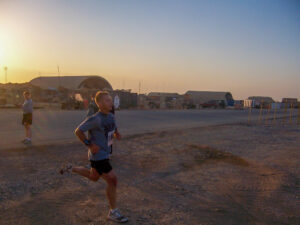
Matt Cavanaugh runs a 10K at a base in Iraq in early 2006.
The Past
Matt Cavanaugh came to running later in life. Like a true Minnesotan, he grew up playing ice hockey. He stuck with the sport all the way through university. Then an injury put an abrupt stop to his career. Cavanaugh broke his leg and during a following knee surgery, the doctors removed a third of his patella tendon. That was the end of his athletic life—at least for the time being.
Cavanaugh eventually joined the army. A Lieutenant, he spent the first few years of his service in Iraq. It might sound like an unlikely place to start a running career; he did just that. At the end of his second year there, Cavanaugh laced up his shoes and went for a run around the army base where he was stationed. A two-by-four-kilometer perimeter of “safe enough” space that surrounded the base made up his running track.
Cavanaugh started to run around the border, gradually increasing the distance. One day, he could run the entire perimeter; the boundary became too small for him.
“I eventually got to the point where I could run the whole perimeter,” he said. “It was a big deal… It was a period of my life that was not positive to say the least, and running gave me something to focus on.”
In Cavanaugh’s own words, there is “an awful lot of wild dogs” in Iraq. One day, as he was running his usual lap, about a dozen of them slipped under the fence that ran around the base and went after him. A thought shot through his head; “I made it through two years of combat and I’m gonna end with being consumed by a pack of wild dogs… or get rabies.”
Luckily, a tower guard noticed what was going on and fired a warning shot, scaring the dogs away. Instead of rabies, Cavanaugh came back from Iraq with a new running habit.
The Donation
“Running gave me a healthy self,” said Cavanaugh. Knowing how hard it is to not be healthy, he wanted to give that feeling to someone else. That’s why, on September 15, 2021, he headed out to a hospital to donate a kidney.
“Seven more people were able to receive a kidney because I didn’t need one back,” said Cavanaugh.
He spent one night in the hospital and “walked out the next day.” Cavanaugh never met the recipient of his kidney and he doesn’t have a single photo of himself in a hospital gown pre- or post-donation.
“I didn’t think about any of this,” he said. “I didn’t think that I would someday be talking to you for example.”
27 days post-surgery, Cavanaugh went out for a jog while the recipient of his kidney was starting a new, better life.
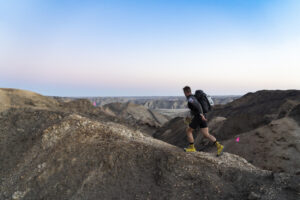
Matt Cavanaugh runs a ridgeline during the Namib Race. Photo credit: Thiago Diz/Racing the Planet.
According to Cavanaugh, most living donors are out of the hospital in one to two days. The biggest concern is usually how the abdomen heals—Cavanaugh could jog lightly one month after the surgery. The most prominent change he had to do in his life (and one that every living kidney donor needs to do) was to switch painkillers.
Cavanaugh had a “bon voyage” glass of red wine before the donation and celebrated with another one the day he came out of the surgery. The procedure had no impact on his sexual health either. Cavanaugh, just like thousands of others, can go on with his life almost as if nothing happened. Only almost. There is one thing different from before; Cavanaugh’s life got better.
“My life now has been amplified by the donation,” he said. While he felt no difference physically, Cavanaugh said he was “upgraded mentally:”
“You’re never allowed to forget that at some point in your life, you did something for someone else.”
—Matt Cavanaugh
For Cavanaugh and many others, having donated is a “permanent psychological boost” comparable to runner’s high.
“You can go out and beat yourself up after you donate,” said Cavanaugh, and that’s exactly what he did. While he started with light jogging post-op as advised, he didn’t really take it as slow when it came to racing.
The Trans Rockies Run is one of Cavanaugh’s favorite races. During this long-distance adventure, runners cross a total of 200 kilometers (roughly 125 miles) over the span of six days. It’s a supported run, which means that the organizations provide and/or transfer shelter, sleeping bags, food, water, and other crucial supplies.
On the other hand, Racing the Planet’s desert races are self-supported. This means that athletes who take on the challenge have to cover 155 miles carrying everything they’ll need over the span of the race week. And Cavanaugh decided to complete four of these grueling races.
1 Kidney, 4 Deserts: Racing the Planet’s Grand Slam
Six weeks after Cavanaugh donated his kidney, he proposed creating and completing the 1K4D project. He could finish the Trans Rockies run, donate a kidney, and then complete one of the hardest challenges in existence. In his own words, donating a kidney wasn’t a subtraction; it was addition if not multiplication. Cavanaugh was stronger for having done it, not the other way around.
He was right. During the 4 Deserts races, many people messaged him on social media. Two of them wanted to share the news: Cavanaugh’s story inspired them and they were starting their journey to become living kidney donors.
HILARY BAUDE
Not all heroes wear capes. Hilary Baude is a “normal person,” as she described herself. She’s a kindergarten teacher, a mom, a wife, a student, an athlete,… oh, and a hero.
Baude didn’t always run. She was an avid swimmer. Then a few very traumatic experiences hit in quick succession and soon, as counterintuitive as it might sound to some, running was the one way for her to keep going.
“Running is something that saved me in a way,” said Baude. It gave her “an outlet and a way to process emotions in a productive way.”

Hilary Baude with her husband and daughters. Photo Credit: Dayna Cass/The 50 Athletes
The Past
After Baude and her husband got married, they knew they wanted to start a family. For five years, they struggled with infertility. This was followed by IVF treatment, a process that is often traumatic in and of itself. Finally, Baude got pregnant, and together with her husband, she looked forward to welcoming their identical twins into the world.
About halfway through the pregnancy, the couple lost one of the twins. The other one wasn’t expected to survive, either.
“It’s like a stroke for the surviving twin,” said Baude. “If she did survive, we were told that she’d have very severe brain damage.”
The doctors suggested terminating the pregnancy. The Baudes decided to keep going. In the end, Baude gave birth to a girl. She was premature, only 2 lbs 3oz, and spent six weeks in the NICU. The skin on her legs didn’t form properly and with two holes in her heart, she survived until she was five months old when she had open heart surgery.
The surgery was successful. Even though she still needed and, until today, needs to have a few more surgeries to improve the skin on her legs, things started to finally look up for the Baude family. It was time for them to take a deep breath and start healing together. The Baudes celebrated their daughter’s first birthday— “and then… my husband was diagnosed with cancer,” said Baude.
The solid ground they finally found was very quickly ripped from under their feet. After that, “We were just trying to survive day to day for a couple of years,” said Baude.
Baude never thought she’d ever run a marathon. The people that were doing it were surely crazy. No normal person could or would do it. Running 26.2 miles was hard… but not as hard as what her family has been through in the past few years, Baude realized.
“If my daughter can battle what she’s battling, and my husband can battle what he’s battling, surely I can run a marathon,” she said.
Thus, around the time of her daughter’s first birthday, Baude started running. As she ran, she pushed her daughter in a stroller. Whenever the going got tough, she looked at her and knew that she could keep pushing. Baude treasured the time they spent together. She realized she was “really thankful and blessed” to be able to run. Especially since “there are so many people out there that would love to do this, and they can’t.” For Baude, running has become a “celebration of life.”
Having been through so much hardship, Baude learned one important lesson for life as well as running:
“When you’re going through it, you just do it.”
—Hilary Baude
Baude’s husband eventually recovered and soon, they welcomed their second daughter into the family. Things finally quieted down and Baude had the time to start processing all that had happened over the years. Running was perfect for that. It gave her the space needed for healing.
The Donation
On New Year’s Eve of 2020, Baude saw a news story about a man who’d been looking for a kidney. When the news story came out, he’d already been searching for about five years. He had a young daughter and, even though dialysis treatments have become better, not a lot of time left.
“I knew instantly that I would donate,” said Baude.
“And he said, ‘Well, actually, I’m an Ironman. So, yes.’ It was a perfect match,” said Baude.
Just like Cavanaugh, Beaude got more out of the donation than she bargained for, in all the best ways imaginable.
“In its own way, donating my kidney to someone and helping heal them, healed me in so many deeper ways than I ever anticipated,” said Baude. “I had no idea that I would get more out of this than I gave away.”
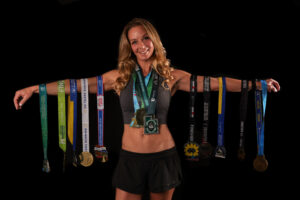
Hilary Baude with her race medals. Photo Credit: Dayna Cass/The 50 Athletes
Two weeks after the donation, Baude was given the green light to start running again. In her own words, “That’s not usually the norm.” Her surgeon felt comfortable with letting Baude run because she had good core strength. She wasn’t out there doing hard 10-kilometer workouts, but she was jogging lightly.
Six months post-op, Baude completed the New York Marathon.
While both Cavanaugh and Baude plan to take a break from running marathons in August, Baude is heading out to complete an Ironman with the hopes of qualifying for Ironman Kona.
The Why: The Decision to Donate
Donations don’t just happen on their own. Living donors have to decide that they want to save a life and then actively participate in the donation preparations. At the National Kidney Donation Organization (NKDO), they’re matched up with a mentor. They need to get ready both physically and mentally for the donation. Despite knowing all the good facts—not only are they going to save a life, but the procedure is also very safe—the whole process might sound a little scary to donors. To walk through it, it helps to have a why.
Hilary Baude
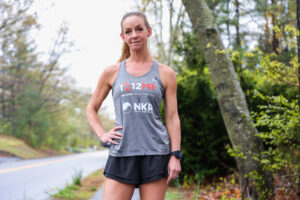
Hilary Baude on a run in the 1K12M official tee. Photo credit: Dayna Cass/The 50 Athletes.
The man to whom Baude gave her kidney spent five years searching for it. That was about the same amount of time the Baudes spent trying to conceive. Something about that connection sealed the deal. Baude knew well the pure despair he must have felt and wanted to end it immediately.
“I could relate to that feeling of being desperate. Of ‘somebody, help me.’ And I would have given anything at the time that we were going through our struggles for someone to say, ‘I have the solution for you. I have your cure.’ And I had the ability to do just that for Mark,” said Baude.
Matt Cavanaugh
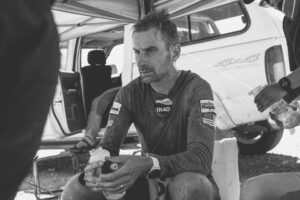
Matt Cavanaugh at the Namib Desert Race. Photo credit: Thiago Diz/Racing the Planet.
Once he learned about live kidney donations, it wasn’t a question of ‘if’ but ‘when.’ Cavanaugh himself was saved in the past. Paying it forward was as natural as breathing.
“The ability as a person to be resilient enough to give a little bit of yourself so that someone else has a more normal life, a better life, that makes every second of it worth it,” he said.
How 1K12M Came to Be
Running deserts is great but there’s one problem: you don’t meet too many people there. To spread the word about live kidney donations more effectively, Cavanaugh had to come up with something else. Thus, the 1K12M project came to be. He would run 12 of the biggest marathons he could find in populated cities across the US to make as much influence as possible. He got in touch with the National Kidney Registry (NKR), the National Kidney Donation Organization, and The Living Donor Games and the project could take off.
The project is an opportunity to demonstrate durability and resilience and show that one can heal quickly from the donation and get back to the start line.
“I’m coming to San Francisco because I want other runners to see in person that you can donate and then go on to post a good time,” Cavanaugh said.
In November 2022, Baude was at the annual NKDO conference. There, Cavanaugh shared his idea for the 1K12M project. Baude knew immediately she’d like to take part. Together with her mentor, she approached Cavanaugh, who got in touch with NKR. The National Kidney Registry agreed to sponsor Baude as well as Cavanaugh—and the deal was sealed.

Matt Cavanaugh runs next to a water hole during the Atacama Crossing. Photo Credit: Thiago Diz/Racing the Planet
“I felt it was important to have a woman be a part of the endeavor,” said Baude. According to her, it was crucial to have a working mother with a full-time job to represent women who “have a lot on our plates but that doesn’t mean that we can’t take on these challenges and advocate for something that we believe in.”
The National Kidney Donation Organization & The Living Donor Games
NKDO aims to advocate for, inform, and support living donors during their donation journey. They “educate prospective living kidney donors to donate as safely and effectively as possible. (NKDO)” But why are living donors needed? After all, quite a few people have that pink ‘organ donor’ dot on their driving licenses.
The Numbers
According to Penn Medicine, “Although almost 170 million people are registered to be donors, only three in 1,000 people die in a way that allows for deceased organ donation.” That statement also includes all organs; this statistic gets a little worse still when it comes to kidney donations.
The numbers speak for themselves. According to Health Resources & Services Administration (HRSA), 17 people die daily waiting for an organ transplant. The NKDO website shows that 13 of these people die while waiting specifically for a kidney. HRSA writes that 104,234 people are waiting for an organ transplant, 85% for a kidney. According to the NKDO website, 102,950 people are currently waiting for a kidney.
(Please note: HRSA data was collected in January 2023. NKDO doesn’t display a data collection date. Therefore, the numbers don’t necessarily match up perfectly and can differ by the time you’re reading this article.)
The Games
The Living Donor Games organization exists to bridge the gap between what people think living donors’ lives look like and what they actually look like post-donation. Of course, you don’t have to run marathons or climb mountains after you donate a kidney—but you can.
“In a general population survey, 75% of respondents felt that donating a kidney would negatively affect their health. The Donor Games refutes this widely held misconception by showcasing the impressive health and fitness of donors from around the country.”
— The Living Donor Games
The Living Donor Games backed Cavanaugh’s 1K4D project. Together with the National Kidney Registry, the sponsor of Cavanaugh and Baude’s current project, it stands behind 1K12M, too.
1K12M and the San Francisco Marathon
The San Francisco Marathon is excited to be supporting Hilary Baude and Matt Cavanaugh on their mission to save lives through running. The organization was able to comp both athletes’ race registration fees. These would otherwise have been paid by NKR. This way, NKR can use the funds for other projects and to further support its mission.
“The San Francisco Marathon has been very supportive of our efforts,” said Baude. “they’ve really tried to make sure that we’re getting what we need to make this endeavor successful.”
This is not the first time the San Francisco Marathon is hosting athletes who have touched the lives of others in the most profound ways. Many of our runners race with a bigger meaning. Just last year, living kidney donor Ashley Zirkle tackled the San Francisco hills as a part of Degree’s Not Done Yet Marathon Program. Zirkle together with a blind athlete Mike Zampella and a multiple-sclerosis survivor Sagirah Ahmed Norris showed everybody that there are really no limitations to what one can accomplish.


